| Author |
Message |
|
Kerry Wallis
Location: Taranaki, New Zealand Joined: 21 Nov 2005
Posts: 12
|
 Posted: Tue 22 Nov, 2005 2:36 am Post subject: Germanic Two Handed Sword, or very good fake? Posted: Tue 22 Nov, 2005 2:36 am Post subject: Germanic Two Handed Sword, or very good fake? |
 |
|
Hello Forum Members,
I was directed to this Forum by a very helpful and knowledgable member from another Forum, who has offered lots of very interesting comments and observations regarding this sword.
I'm what you would describe as an 'accidental newbee sword collector' while innocently studying my Scottish ancestory during the last 12 months or so. I have recently purchased 3 swords that I intended to hang on the walls of my Medieval styled cottage. One of these swords is a curiosity that I wish to find the age and origin of. It was my 1st purchase of a sword that a friend alerted me to. I hadn't even considered owning one, but this one really caught my eye! He thought it would look just right above the fireplace. The other two swords are simply hangers of no interest other than their beauty. Both equally difficult to weild due to horrendeous POB, one of which is a interpretation of the Wallace sword.
I now have had this sword for a few weeks and have been seduced by it's size,weight and balance. So much so that I take it out to the backyard late every night and use it as another form of exercise. Have now started to become quite 'handy' with it, not to mention the increase in my upper body strength. It is so easy to weild one or two handed!
A member posted on this forum about ideal POB,( Myer). This sword has a POB at about 5 fingers (4 1/2")below the cross-guard and weighs 7.62lbs or 3.46kg. It's total length is 55 1/4" or 1403mm. The cross-guard is 11 1/2" long and made of solid bronze. The handle is 13" from the hilt to the base of the pommel and 1 1/4" at it widest point, not including the grip rings.The handle is very nicely 'wasted'. The blade is double edged, and only just dull with a length of 30" to the base of the rocasso, and 1 3/4" at it widest point. The rocasso is 9 1/4" to the hilt and leather clad with no lower grip ring. The blade is tempered carbon spring steel with excellent 'memory' when flexed. If I hold the sword horizontal and tap the blade with my other hand it 'sings'quietly and continues a very small occillation for quite a period. The pommel,said to be 'continental' in style with 6 fluted segments is 3" long and 1 3/4"dia at it's widest point. The pommel is solid bronze,very heavy, and is internally threaded with a recess that covers a 7/16" nut cut with a Whitworth thread which is 1 1/4" in length and part of the tang,eg no weld. The handle appears to be 'Ash' covered in smooth leather that has been secured using animal hide glue, which has broken down slightly, as is the rocasso cover. There are two wedges either side of the tang that are very thin(1/32" tapering to roughly 1/16") and 8" long. They look to be 'Elm' ? The handle was very difficult to remove and was very dirty,gritty and smelly,( I left it that way on reassembly, though was very tempted to clean it up!).
The blade appears to have had quite a number of strikes, but most appear just over half way down the blade, more on one face than the other. The sword I and others believe, has been well used judging by the wear on the rocasso and at the base of two of the pommel segments, and of course the handle, mainly very close to the hilt (evidence of hand wear on the top shoulder of the bronze cross where a index finger would rest) and the front grip ring.
I'm not going to describe the stamps, other than to say a 'crown' is at the base of the rocasso stamped into the leather, but rather post a photo or two of them with detail notes. It has been viewed by a foundry caster and a member of a Medieval Society, both believe it is old and possibly an early re-enactment sword 'wardrobe' sword for film making.
If it turns out to be a modern fake, the maker has done a fine job! But I need to know.
If anyone here can help me identify the age and maker of this sword I would be very grateful. I thank you all in advance 
 Attachment: 31.36 KB Attachment: 31.36 KB
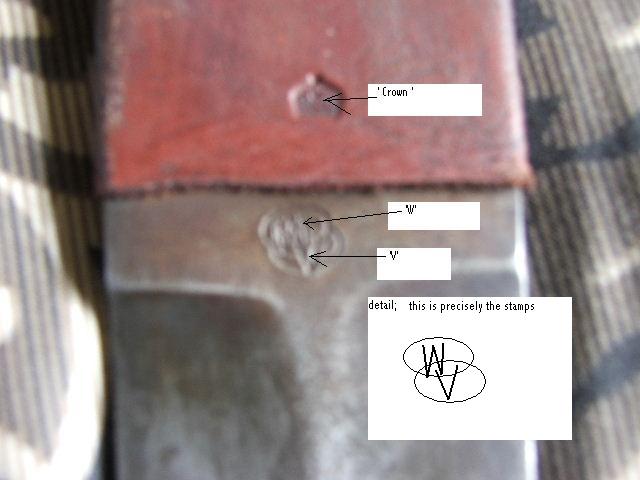
Cabinetmaker living contently in rural New Zealand
"Ki ora" and welcome to stunning 'Aotearoa'
|
|
  |
 |
|
Kerry Wallis
Location: Taranaki, New Zealand Joined: 21 Nov 2005
Posts: 12
|
 Posted: Tue 22 Nov, 2005 2:38 am Post subject: Germanic? Posted: Tue 22 Nov, 2005 2:38 am Post subject: Germanic? |
 |
|
... this is the other side
 Attachment: 27.94 KB Attachment: 27.94 KB

Cabinetmaker living contently in rural New Zealand
"Ki ora" and welcome to stunning 'Aotearoa'
|
|
  |
 |
|
Kerry Wallis
Location: Taranaki, New Zealand Joined: 21 Nov 2005
Posts: 12
|
 Posted: Tue 22 Nov, 2005 2:42 am Post subject: Germanic? Posted: Tue 22 Nov, 2005 2:42 am Post subject: Germanic? |
 |
|
...the pommel
 Attachment: 33.85 KB Attachment: 33.85 KB
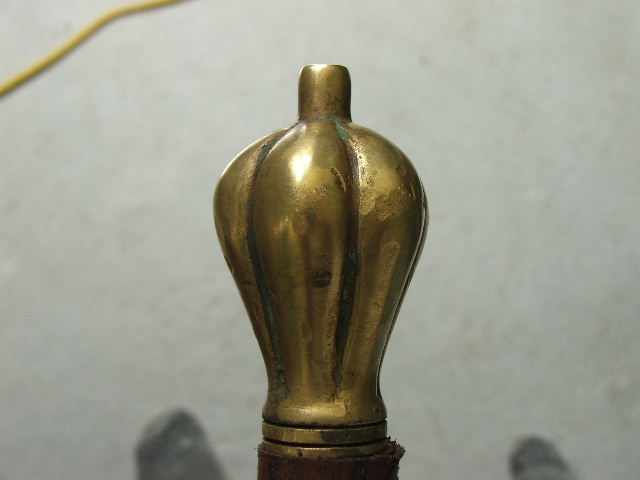
Cabinetmaker living contently in rural New Zealand
"Ki ora" and welcome to stunning 'Aotearoa'
|
|
  |
 |
|
Kerry Wallis
Location: Taranaki, New Zealand Joined: 21 Nov 2005
Posts: 12
|
 Posted: Tue 22 Nov, 2005 2:44 am Post subject: Germanic? Posted: Tue 22 Nov, 2005 2:44 am Post subject: Germanic? |
 |
|
...full length 55 1/4"
 Attachment: 44.48 KB Attachment: 44.48 KB
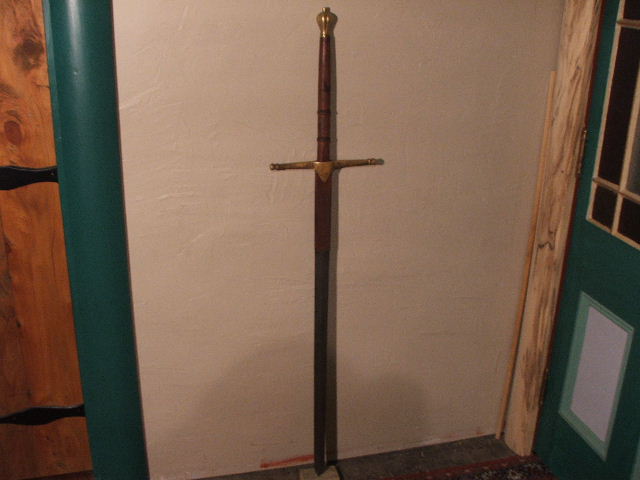
Cabinetmaker living contently in rural New Zealand
"Ki ora" and welcome to stunning 'Aotearoa'
|
|
  |
 |
|
Kerry Wallis
Location: Taranaki, New Zealand Joined: 21 Nov 2005
Posts: 12
|
 Posted: Tue 22 Nov, 2005 2:49 am Post subject: Germanic? Posted: Tue 22 Nov, 2005 2:49 am Post subject: Germanic? |
 |
|
... the hilt assembly, sorry I forgot the wedges!
 Attachment: 36.65 KB Attachment: 36.65 KB
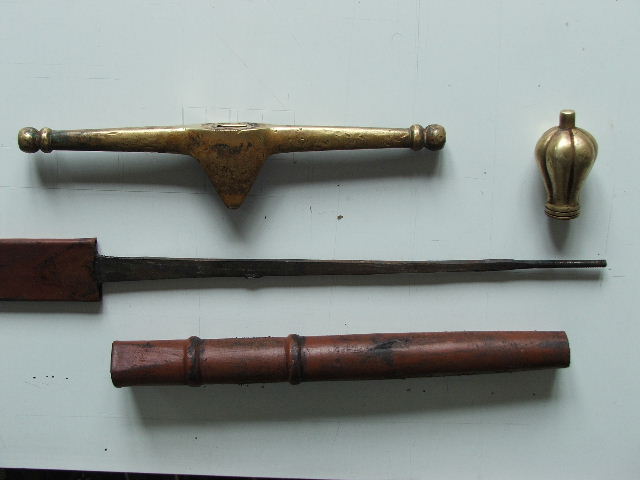
Cabinetmaker living contently in rural New Zealand
"Ki ora" and welcome to stunning 'Aotearoa'
|
|
  |
 |
|
Kerry Wallis
Location: Taranaki, New Zealand Joined: 21 Nov 2005
Posts: 12
|
 Posted: Tue 22 Nov, 2005 2:53 am Post subject: Germanic? Posted: Tue 22 Nov, 2005 2:53 am Post subject: Germanic? |
 |
|
.. portion of the blade
 Attachment: 36.58 KB Attachment: 36.58 KB
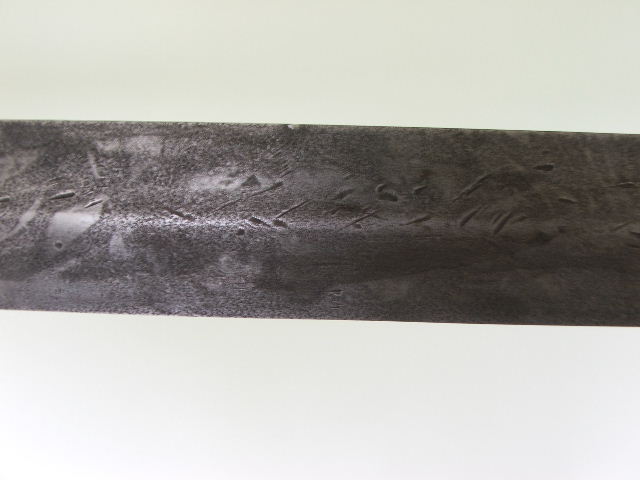
Cabinetmaker living contently in rural New Zealand
"Ki ora" and welcome to stunning 'Aotearoa'
|
|
  |
 |
Bill Grandy
myArmoury Team


|
 Posted: Tue 22 Nov, 2005 7:49 am Post subject: Posted: Tue 22 Nov, 2005 7:49 am Post subject: |
 |
|
Hi Kerry,
First of all, nice sword! What you have here is a modern reproduction by a company in Spain. I suddenly can't remember their name, but will post when I do. The sword was probably "antiqued" by someone, either for aesthetic reasons, or possibly to unscrupulously make a buck.
One of the first things that's a giveaway is the screw on pommel, as this was not done historically on swords: The pommel would come loose during use.
This type of two handed sword, based loosely on something that one would have seen in the late 15th century or even in the Renaissance, would also unlikely have brass furniture, as brass was soft. I have never seen brass hilt furniture on anything before the 18th century, though it is possible that there are exceptions.
Also, anything in that condition from the middle ages should be viewed with a very critical eye, particularly if it cost less than multiple thousands of dollars. 
FYI, if you ever do pick up another sword that you suspect to be an antique, please don't take the hilt apart! You could do more damage than good!
HistoricalHandcrafts.com
-Inspired by History, Crafted by Hand
"For practice is better than artfulness. Your exercise can do well without artfulness, but artfulness is not much good without the exercise.” -anonymous 15th century fencing master, MS 3227a
|
|
   |
 |
Bill Grandy
myArmoury Team


|
|
   |
 |
Glen A Cleeton

|
 Posted: Tue 22 Nov, 2005 10:28 am Post subject: Posted: Tue 22 Nov, 2005 10:28 am Post subject: |
 |
|
Hi Bill,
One of my thoughts about this sword not being associated with the movie sword is the blade itself. The spurious reprodutions of the Del Tin and the Marto are quite different in crossection, particularly at the transition from ricasso to the edges.
Granted, any "Made In" marks could have been easily removed and the whole of the sword artificially antiqued/distressed but the imrpession I'm getting is that it is more along the lines of a much earlier reproduction.
I had not yet pursued the avenue of contacting Fulvio at Del Tin and asking what the true inspiration of the movie sword was. I had hoped someone might be able to dig up something to brace the comments that Del Tin was working in the style of a Germanic two hander from the 15th-16th century.
Even the Kolombatovitch swords bear the Spain mark.
What has been a lot in unsaid comment about this sword is any remark from some of the big guns here and at SFI All I can assume is that they are either more or less in agreement to a late 19th, early 20th century sword or are still musing a bit.
Artificially aged was one of my first thoughts but there is something about the blade that seems (to me) like some true age. As I see it, any furhter context to the movie sword would benefit from where the inspiration came from.
Kerry, glad you made it. I'm not having much luck with artwork and museum searches.
Cheers
GC
|
|
  |
 |
|
Patrick Kelly
|
 Posted: Tue 22 Nov, 2005 10:37 am Post subject: Posted: Tue 22 Nov, 2005 10:37 am Post subject: |
 |
|
Bill's correct, it's a faked up modern sword.
As Bill mentioned: the screw-on pommel is a dead giveaway all by itself. The hilt components are brass, you will never find hilt components made of brass during the middle ages. Bronze rarely, but never brass as it's far too soft for something like the guard on a large cutting sword like this. Pommels were made of latten from time to time and this is similar to brass, but never the gaurd.
There's no confusion here. No one else commented because Bill is absolutely correct.

"In valor there is hope.".................. Tacitus
|
|
   |
 |
Chad Arnow
myArmoury Team


|
 Posted: Tue 22 Nov, 2005 10:48 am Post subject: Posted: Tue 22 Nov, 2005 10:48 am Post subject: |
 |
|
| Patrick Kelly wrote: | The hilt components are brass, you will never find hilt components made of brass during the middle ages. Bronze rarely, but never brass as it's far too soft for something like the guard on a large cutting sword like this. Pommels were made of latten from time to time and this is similar to brass, but never the gaurd.
|
Patrick,
Actually, I'm not sure the exact chemical composition of latten has been determined, nor was a particular combination of elements likely standard worldwide. Some say it's analogous to brass. Some say it's a brass-bronze combo. Some websites define latten as an Elizabethan term for brass. Other sites define it as "Brass or a similar alloy." The French word for brass is laiton.
I'm pretty sure there are examples of swords with latten guards and I know there are at least two with copper guards (even softer than brass). Of course, people debate whether these swords were battlefield weapons and/or if the guards were original.
It's safe to say brass is less strong than bronze and steel, and that it was less common and/or uncommon during the time. Blanket statements like "never" aren't always the best idea. 
That being said, I'd have to agree that this sword is likely not original.

ChadA
http://chadarnow.com/
|
|
    |
 |
|
Patrick Kelly
|
 Posted: Tue 22 Nov, 2005 10:58 am Post subject: Posted: Tue 22 Nov, 2005 10:58 am Post subject: |
 |
|
Well Chad I suppose if you want to debate semantics I'll oblige. You're right, things such as latten, copper, and bronze, were on occasion used for sword guards. I believe I pointed that out with my bronze example (my apologies for not going through the entire shopping list  ). However, brass in it's modern metallurgical composition was never used for a sword's guard in the medieval period, or for a pommel for that matter. This sword's furniture appears to be brass from the way it has patinated or been artificially aged. This alone is a dead giveaway as to it's origin as a modern repro. ). However, brass in it's modern metallurgical composition was never used for a sword's guard in the medieval period, or for a pommel for that matter. This sword's furniture appears to be brass from the way it has patinated or been artificially aged. This alone is a dead giveaway as to it's origin as a modern repro.
I'm aware of swords with bronze and even copper guards, if you have a source for one with a latten guard I'd like to see it. I'm also aware of the the latten/brass debate. That's why I stated that it's "similar" not exact. I do agree that my use of the term "never" isn't the best verbiage.
Shall we discuss the metallurgical composition of non-ferrous metals, and their use the the medieval context further, or shall we concentrate on whether this sword is genuine or not? 
"In valor there is hope.".................. Tacitus
|
|
   |
 |
|
Patrick Kelly
|
 Posted: Tue 22 Nov, 2005 11:30 am Post subject: Posted: Tue 22 Nov, 2005 11:30 am Post subject: |
 |
|
Also, if you observe the pattern in the corrosion/patina on the blade it appears to me that some kind of liquid solution has been used to artificially age it.
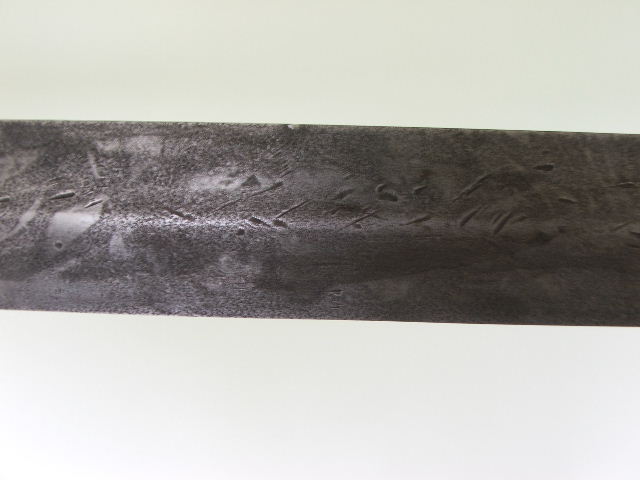
The edge looks awfully pristine for a blade that has taken that much damage on it's flat. If the blade had been rehoned to restore the edge you would probably expect to see some waviness to the edge.
It's not a bad looking sword, and not a bad job at artificially aging it.
Kerry,
Here's an excellent article that explains how this can be accomplished.
http://www.myArmoury.com/feature_antique.html
"In valor there is hope.".................. Tacitus
|
|
   |
 |
|
Allan Senefelder
Industry Professional
|
 Posted: Tue 22 Nov, 2005 11:47 am Post subject: Posted: Tue 22 Nov, 2005 11:47 am Post subject: |
 |
|
|
Looks like the blade was wrapped in a cloth soaked in the oxidizing(rusting) agent and wasn't smoothed out so there were pockets in the cloth that didn't contact the blade creating the "clean" spots. When I screwed around with this some years back I got a very similar look on my first try (I used bleach which is pretty aggressive) because I didn't make sure the rag was contacting the metal throughout.
|
|
   |
 |
Chad Arnow
myArmoury Team


|
 Posted: Tue 22 Nov, 2005 12:16 pm Post subject: Posted: Tue 22 Nov, 2005 12:16 pm Post subject: |
 |
|
| Patrick Kelly wrote: | Well Chad I suppose if you want to debate semantics I'll oblige. You're right, things such as latten, copper, and bronze, were on occasion used for sword guards. I believe I pointed that out with my bronze example (my apologies for not going through the entire shopping list  ). However, brass in it's modern metallurgical composition was never used for a sword's guard in the medieval period, or for a pommel for that matter. This sword's furniture appears to be brass from the way it has patinated or been artificially aged. This alone is a dead giveaway as to it's origin as a modern repro. ). However, brass in it's modern metallurgical composition was never used for a sword's guard in the medieval period, or for a pommel for that matter. This sword's furniture appears to be brass from the way it has patinated or been artificially aged. This alone is a dead giveaway as to it's origin as a modern repro.
Shall we discuss the metallurgical composition of non-ferrous metals, and their use the the medieval context further, or shall we concentrate on whether this sword is genuine or not?  |
Yes we shall.  Since one of your main condemnations of the sword centers on the use of brass, I think it's relevant to discuss a little of that here. Since one of your main condemnations of the sword centers on the use of brass, I think it's relevant to discuss a little of that here.
As to your statement that modern brass (metallurgically speaking) was never used, can you suggest reference works so I can read up on this? I haven't heard it conclusively proven that latten and modern brass are different. Yes, it does appear that the sword's furniture is brass, given the telltale green patination in the crevices.
As for swords with latten guards, I found more with copper guards (most often gilt), a much weaker material, during a quick glance through Oakeshott's Records of the Medieval Sword. One with a latten guard, though, is. Xa.17 (whose hilt material was shown to be 15th century latten by the Royal Armouries).
I agree that it wasn't common or typical or as strong as steel or bronze, and that this sword is likely a modern one. I'm not convinced, though, that you can back up this quote:
| Quote: | | However, brass in it's modern metallurgical composition was never used for a sword's guard in the medieval period, or for a pommel for that matter. |

ChadA
http://chadarnow.com/
|
|
    |
 |
|
Patrick Kelly
|
 Posted: Tue 22 Nov, 2005 12:22 pm Post subject: Posted: Tue 22 Nov, 2005 12:22 pm Post subject: |
 |
|
| Quote: | As for swords with latten guards, I found more with copper guards (most often gilt), a much weaker material, during a quick glance through Oakeshott's Records of the Medieval Sword. One with a latten guard, though, is. Xa.17 (whose hilt material was shown to be 15th century latten by the Royal Armouries).
|
Thanks for that resource. I stand corrected! Xa.17 has always been of interest to me since it's an excellent example of an older blade being rehilted at a much later date. I don't know why I had forgotten about it.
As for the composition of brass I'll have to look it up. I've got something on it somewhere in the library. If I remember correctly latten generally has a bit higher tin content so is actually closer to bronze that brass.
We can stretch the relavence of my statement ad nauseum if you really want to but it won't help the provence of the sword in question, which is obviously not an antique.
"In valor there is hope.".................. Tacitus
|
|
   |
 |
Glen A Cleeton

|
 Posted: Tue 22 Nov, 2005 12:27 pm Post subject: Posted: Tue 22 Nov, 2005 12:27 pm Post subject: |
 |
|
| Patrick Kelly wrote: | <snip>or shall we concentrate on whether this sword is genuine or not?  |
The the only real questions I had about this likely reproduction were the true age of manufature and the company/maker that produced it. The blade is significantly different than the reprodutions (I've seen) from the past ten years.
My only other real curiousity is whether there is reference to a similar sword that Del Tin made his version in the style of.
Cheers
GC
|
|
  |
 |
|
Patrick Kelly
|
 Posted: Tue 22 Nov, 2005 12:36 pm Post subject: Posted: Tue 22 Nov, 2005 12:36 pm Post subject: |
 |
|
| Glen A Cleeton wrote: | | Patrick Kelly wrote: | <snip>or shall we concentrate on whether this sword is genuine or not?  |
The the only real questions I had about this likely reproduction were the true age of manufature and the company/maker that produced it. The blade is significantly different than the reprodutions (I've seen) from the past ten years.
My only other real curiousity is whether there is reference to a similar sword that Del Tin made his version in the style of.
Cheers
GC |
Since Braveheart several makers have copied this design, Del Tin, CAS-Iberia, etc. Arms& Armor made a custom version a few years ago. I believe Del Tin made/makes the best version with the Phillipine made examples offered by CAS-I a distant second. In fact, I believe the original movie sword was made using a Del Tin blade. Del Tin has never made a version with hilt components of a yellow non-ferrous metal of dubious quality  but other companies have. but other companies have.
How is the blade significantly different in design to other you've seen?
"In valor there is hope.".................. Tacitus
Last edited by Patrick Kelly on Tue 22 Nov, 2005 12:40 pm; edited 2 times in total
|
|
   |
 |
Nathan Robinson
myArmoury Admin


|
 Posted: Tue 22 Nov, 2005 12:38 pm Post subject: Posted: Tue 22 Nov, 2005 12:38 pm Post subject: |
 |
|
| Glen A Cleeton wrote: | | Even the Kolombatovitch swords bear the Spain mark. |
Just to add my experience, though not particularly relevant to this topic (  ) -- Not one of the 20+ Kolombatovich items i've owned or the several dozen others I've seen at American Fencers (200 feet away from my house) have had a Spain mark. They all had adhesive stickers that were promptly removed though. ) -- Not one of the 20+ Kolombatovich items i've owned or the several dozen others I've seen at American Fencers (200 feet away from my house) have had a Spain mark. They all had adhesive stickers that were promptly removed though.
.:. Visit my Collection Gallery :: View my Reading List :: View my Wish List :: See Pages I Like :: Find me on Facebook .:.
|
|
    |
 |
|
Patrick Kelly
|
 Posted: Tue 22 Nov, 2005 12:39 pm Post subject: Posted: Tue 22 Nov, 2005 12:39 pm Post subject: |
 |
|
[quote="Nathan Robinson"] | Glen A Cleeton wrote: | | Bill Grandy wrote: | | Even the Kolombatovitch swords bear the Spain mark. |
Just to add my experience, though not particularly relevant to this topic (  ) -- Not one of the 20+ Kolombatovich items i've owned or the several dozen others I've seen at American Fencers (200 feet away from my house) have had a Spain mark. They all had adhesive stickers that were promptly removed though. ) -- Not one of the 20+ Kolombatovich items i've owned or the several dozen others I've seen at American Fencers (200 feet away from my house) have had a Spain mark. They all had adhesive stickers that were promptly removed though. |
My older ones had "SPAIN" stamped into the base of the blade.
"In valor there is hope.".................. Tacitus
|
|
   |
 |
|
|
You cannot post new topics in this forum
You cannot reply to topics in this forum
You cannot edit your posts in this forum
You cannot delete your posts in this forum
You cannot vote in polls in this forum
You cannot attach files in this forum
You can download files in this forum
|
All contents © Copyright 2003-2024 myArmoury.com — All rights reserved
Discussion forums powered by phpBB © The phpBB Group
Switch to the Basic Low-bandwidth Version of the forum
|

